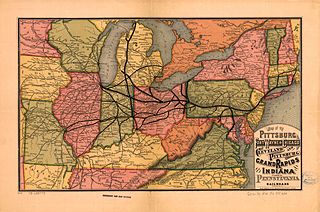
Railroads have been vital in the history of the population and trade of rough and finished goods in the state of Michigan. While some coastal settlements had previously existed, the population, commercial, and industrial growth of the state further bloomed with the establishment of the railroad.

The Mid-Michigan Railroad is a railroad owned by Genesee & Wyoming. It operates 39.8 miles of track in Michigan.
The Flint River Railroad is a defunct railroad. It was established on December 6, 1871 to construct a 14.4-mile (23.2 km) branch from Horton to Otter Lake to support the logging industry in the Flint River area. This line was opened on October 8, 1872, and the company was consolidated with the Flint and Pere Marquette Railroad (F&PM). In 1881 the F&PM extended this line 5.2 miles (8.4 km) to Fostoria.
The Detroit, Lansing and Northern Railroad (DL&N) is a defunct railroad which was formed on December 27, 1876 as a reorganization of the foreclosed Detroit, Lansing and Lake Michigan Rail Road. The segment of its main line from Detroit to Lansing became an important component of the Pere Marquette Railroad, organized in 1900, and is still in use by CSX.
The Chicago and West Michigan Railway (C&WM) is a defunct railroad which operated in the state of Michigan between 1881 and 1899. It was one of the three companies which merged to become the Pere Marquette Railway.
The Paw Paw Railroad is a defunct railroad which operated in Van Buren County, Michigan, between 1857 and 1887. At a length of 4 miles (6.4 km), it was the shortest operating common carrier railroad in the state. Later, the Ludington & Northern Railway Company, at 2.79 miles (4.49 km), stripped the Paw Paw of its title as "shortest Michigan Railroad".
The Grand Rapids, Kalkaska and Southeastern Railroad is a defunct railroad which operated in Northern Michigan toward the end of the 19th century. The company was founded on August 30, 1897 by William Alden Smith, a Republican politician and former general counsel of both the Chicago and West Michigan Railway and the Detroit, Lansing and Northern Railroad. The GRK&S constructed a 40.73-mile (65.55 km) line from northern Missaukee County through Kalkaska to Rapid City, where it met the C&WM's main line. The C&WM undertook to supply rolling stock and oversee construction in exchange for a 10-year lease of the line.
The Patterson Railroad is a defunct railroad that existed in Michigan during the early 1870s. The company incorporated on September 21, 1870 and filed articles on October 3 to construct a line between Patterson Mills and Kiddville. The Patterson completed a 1.67-mile (2.69 km) in July 1872, at which point the property became part of the Detroit, Lansing and Lake Michigan Railroad, whose line it met at Kiddville. The DL&M would later become part of the Pere Marquette Railroad, which also built a line south from Belding.
The Alpena and Northern Railroad is a defunct railroad which operated briefly in northern Michigan during the 1890s.
The Howell and Lansing Railroad is a defunct railroad which proposed to construct a railway line between Howell and Lansing in central Michigan. The company incorporated on June 23, 1868 and began grading along the 33-mile (53 km) length of the line. The H&L had some difficulty obtaining financing; by the time it merged with the Detroit and Howell on March 29, 1870, no track had been laid. The two companies merged formed the Detroit, Howell and Lansing, and the H&L ceased to exist as an independent company.

The Mansfield, Coldwater and Lake Michigan Railroad (MCW&LM) is a defunct railroad which operated in southern Michigan and Ohio during the 1870s. By the time it went into foreclosure in the late 1870s it owned two non-contiguous track segments, each of which was leased by a different company.
Michigan United Railways (MUR) was an interurban which owned and leased numerous lines in the state of Michigan during the early twentieth century.

The St. Joseph Valley Rail Road is a defunct railroad which operated in southern Michigan during the mid-19th century.
The Grand Rapids, Belding and Saginaw Railroad is a defunct railroad which operated in the state of Michigan at the turn of the 20th century.
Detroit & Howell R Co v Salem Township Board, 20 Mich 452 (1870), is a legal case in which the Michigan Supreme Court held that the Michigan State Constitution of 1850 prohibited the use of public money to finance a privately owned railroad.

The Detroit, Monroe and Toledo Railroad (DM&T) was a shortline railroad which operated in the U.S. states of Michigan and Ohio. Opened in 1856, its main line ran from Detroit, Michigan, to Toledo, Ohio. The railroad leased itself to the Michigan Southern and Northern Indiana Railroad (MS&NI) in 1856. A 1914 merger which created the New York Central Railroad led to the DM&T's consolidation into the new road, ending its existence.
The Kalamazoo and White Pigeon Railroad (K&WP) was a shortline railroad in the U.S. state of Michigan. The line ran from Lansing to Jonesville, then returned north from Jonesville to Albion and Eaton Rapids before closing the loop in Lansing. The NCMR had a short life as an independent company, becoming part of the Lake Shore and Michigan Southern Railway in 1871 and then consolidating with the New York Central Railroad in 1914.







